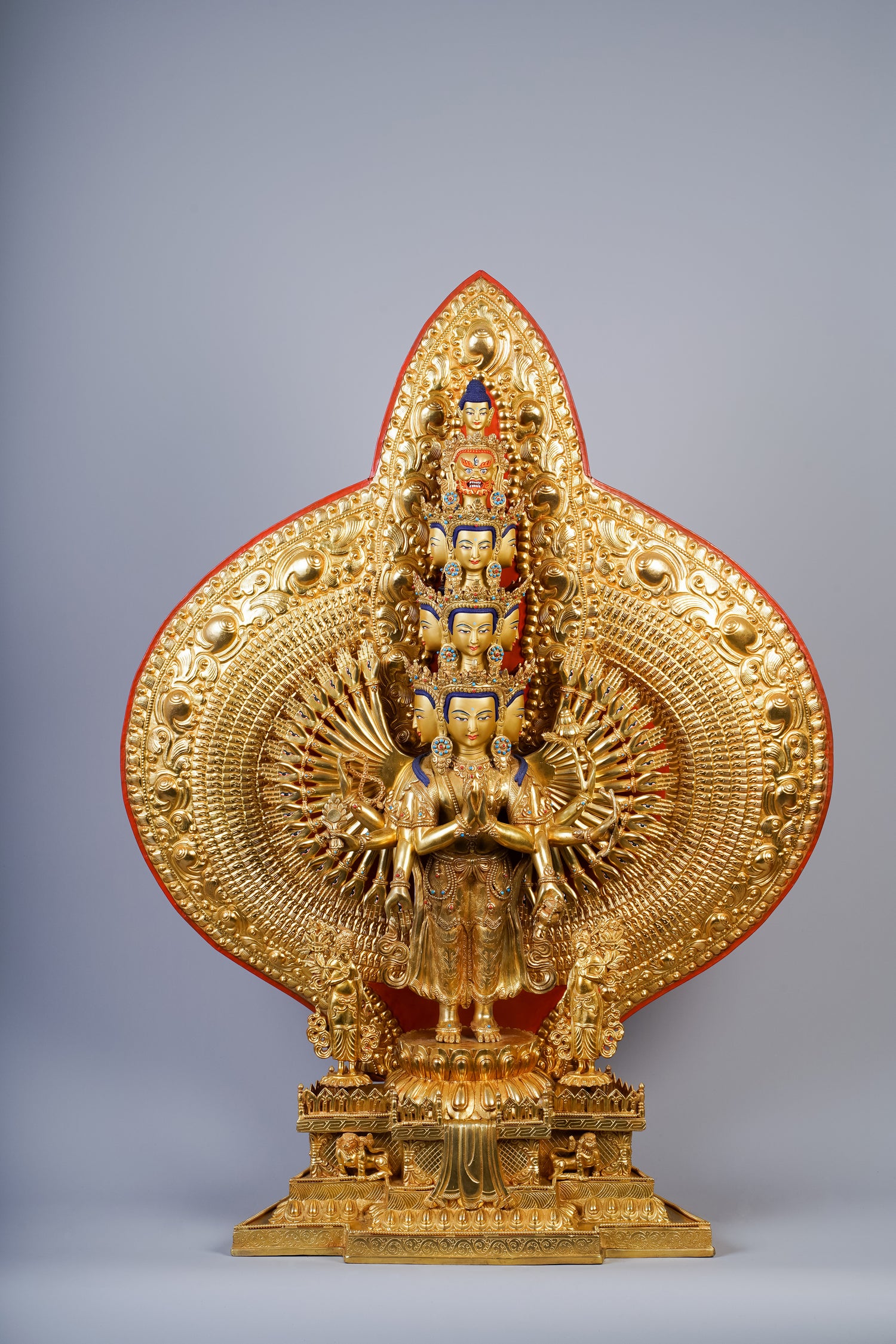
Thousand-Armed Avalokiteśvara — The Infinite Reach of Compassion
Thousand Armed Avalokiteśvara - སྤྱན་རས་གཟིགས་ཕྱག་སྟོང་ - 千手观音
From the vast silence of the dharmadhātu, where form emerges from emptiness for the benefit of sentient beings, rises the magnificent figure of Thousand-Armed Avalokiteśvara—a symbol of compassion beyond comprehension. His body shines with a brilliant white light as he stands on a moon mat and lotus throne, encircled by a radiance as boundless as his vow. Amitābha Buddha crowns him, and his face reflects a blend of fierce determination and serene joy. However, it is his arms—one thousand in total, each with an eye in the palm—that stretch outward in every direction, offering assistance to all beings across all realms.
Eleven heads crown his form, arranged in tiers to perceive all dimensions—cardinal directions, zenith, nadir, and even the subtle center of awareness. His hands hold sacred implements: the wish-fulfilling gem of Bodhicitta, tools for rescue and transformation, and symbols of his infinite adaptability in guiding beings toward awakening.
This form is not merely a fantasy; it serves as a mirror of the awakened mind, entirely restructured by Bodhicitta and the unwavering vow to free all beings from suffering. He is not just one individual with many arms; he embodies a boundless spiritual community, with each hand representing an offering and each action guided by a selfless vision. In him, the individual dissolves into extensive activity, and love extends farther than sorrow.
Iconography of Thousand Armed Avalokiteśvara
Legend: The Vow That Shattered the Sky
Once, long before memory, the Bodhisattva Avalokiteśvara gazed down upon the suffering of beings and made a vow as vast as the sky. He swore that he would liberate all beings from suffering, lead them toward the light of awakening. He added, “If ever I falter, may my body break into a thousand pieces.”
He entered samādhi, a deep and compassionate meditation where time itself seemed to pause. For what felt like eons, he worked tirelessly, drawing beings out of darkness with subtle means, invisible blessings, and guiding dreams.
However, when he emerged and looked back, he realized that not even a hundredth of those he had vowed to help had found freedom. In that instant, despair struck him like lightning. He felt the sorrow of eons collapse in a single breath, and his body, true to his vow, shattered into a thousand pieces.
From that sacred fragmentation came a cry—not of agony, but of longing. In response, from the western sky descended Amitābha, his spiritual father. With transcendent grace, Amitābha gathered the broken pieces and reshaped Avalokiteśvara—not into his old form, but into one capable of fulfilling his vow.
He granted him ten new heads so that he could see in all directions. He gave him a thousand arms to reach every corner of suffering. In each palm, an eye opened, merging the acts of seeing and helping. At the very top of this towering form, he placed his head, signifying the union of boundless compassion with transcendental wisdom.
Thus, Avalokiteśvara returned, no longer broken but multiplied. No longer limited to one heart or one pair of eyes, he had become the infinite Bodhisattva, the living embodiment of the truth: when compassion is shattered, it does not end—it expands.
References
Other forms of Thousand Armed Avalokiteśvara
Commonly associated with
-
Example product title
Regular price $19.99Regular price -
Example product title
Regular price $19.99Regular price -
Example product title
Regular price $19.99Regular price -
Example product title
Regular price $19.99Regular price
